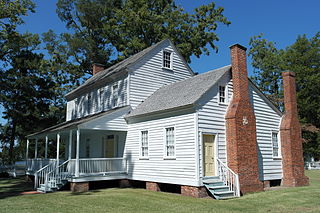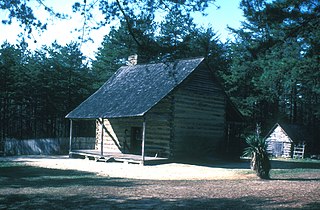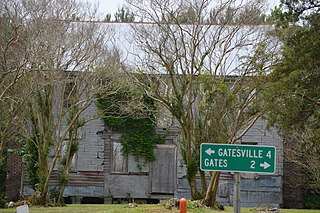
The Heck-Andrews House was finished in 1870 and was one of the first houses in Raleigh, Wake County, North Carolina to be constructed after the American Civil War. It is located at 309 North Blount Street. It was created by G.S.H. Appleget for Mrs. Mattie Heck, the wife of Colonel Jonathan McGee Heck. It is on the National Register of Raleigh Historic Property. The house has a dramatic central tower capped with a convex mansard roof with a balustrade. The central part of the 2+1⁄2-story, Second Empire style frame dwelling is enclosed with a concave mansard roof with patterned slate.

Bonner House is a historic home located at Bath, Beaufort County, North Carolina. It was built about 1835, and is a two-story frame dwelling with a one-story wing and rear shed addition. It sits on a brick pier foundation and has a side-hall plan. It is on land once owned by John Lawson, explorer and founder of Bath.
The Aycock Birthplace, also known as the Charles B. Aycock Birthplace, is a historic home in Wayne County, North Carolina, and a historic site belonging to the North Carolina Department of Natural and Cultural Resources' Historic Sites division. The property was the location of the birth of Governor Charles Brantley Aycock in 1859, and exhibits at the historic site serve to tell the story of the Governor's political career and the education reforms he enacted while in office. It was built about 1840, and is a one-story weatherboard dwelling on a brick pier foundation. It has a gable roof and exterior end chimneys.

Rural Point, also known as Robertson House and Doty House, is a historic home and garden located at Winnsboro, Fairfield County, South Carolina. It was built in 1852, and is a 1+1⁄2-story, 12 bay, Greek Revival style frame dwelling over a high basement. The façade features a gable-roofed porch which is supported by four square columns. The property features a semi-formal garden said to have been designed by John Grimke Drayton, noted landscape architect of Magnolia Gardens in Charleston, South Carolina. Also on the property is a typical southern planter's office of white clapboard. It was built by William Ross Robertson, probate judge and commissioner of equity of Fairfield County who served in South Carolina House of Representatives and as a member of the Secession Convention.

Allen House is a historic home located on the Alamance Battleground State Historic Site near Burlington, Alamance County, North Carolina. It was built in 1782, and is a two-story, hewn log dwelling with a gable roof. It rests on a stone foundation. The Allen house was moved to the Alamance Battleground in 1966 and restored as a homestead dwelling.
Jordan House is a historic home located near Windsor, Bertie County, North Carolina. It was built about 1738, and is a one-story, Quaker plan brick dwelling with a gable roof. It features two interior T-stack end chimneys. The interior was destroyed by fire in 1928.

King House, also known as King-Bazemore House, is a historic plantation house located near Windsor, Bertie County, North Carolina. It was built in 1763, and is a 1+1⁄2-story, frame dwelling with brick ends. It has a gambrel roof and features two interior T-stack end chimneys. It is one of two known gambrel roofed dwellings with brick ends in North Carolina.

Athol, also known as Benbury Hall and Joshua Skinner House, is a historic plantation house located near Edenton, Chowan County, North Carolina. It was built about 1857, and is a 2+1⁄2-story, five bay, "T"-shaped Greek Revival style frame dwelling. The rear section of the house features two-tier porches on either side. The front facade features a full-length two-tiered porch supported by Roman Ionic order columns.

Sandy Point is a historic plantation house located near Edenton, Chowan County, North Carolina. It was built about 1810 and later expanded. It is a 2 1/2-story, five bay, Federal / Greek Revival style frame dwelling with a center hall plan. The front facade features a two-tiered full-length porch and the house has two exterior end chimneys at each side.
Cullins-Baker House is a historic plantation house located near Smalls Crossroads, Chowan County, North Carolina. It was built in the late 1830s, and is a two-story, three-bay, transitional Federal / Greek Revival-style frame dwelling. It has a two-story rear ell and center-hall plan.
Roberts–Carter House was a historic home near Gatesville, Gates County, North Carolina. It was built about 1830 and was a two-story, three-bay, Federal dwelling with a side-hall plan. It was remodeled in about 1860 to add Greek Revival style front and rear double-tier porticos. Also on the property are a contributing kitchen and a smokehouse.

Buckland is a historic plantation house located near Buckland, Gates County, North Carolina. It was built about 1795, and is a two-story, five-bay, transitional Georgian / Federal style frame dwelling with a double-pile center-hall plan. It has paired, double shouldered brick exterior end chimneys. The front facade features a handsome double-tier pedimented portico protecting the central three bays.

Freeman House, also known as The Stateline House, is a historic home located on the North Carolina-Virginia state line near Gates, Gates County, North Carolina, USA. The house was built in three building phases, the earliest perhaps dating to the late-18th century. The farmhouse was initially built following the basic early-Federal-style one-room plan, followed by the addition of a late-Federal-style two-story side-hall-plan, which was finally enlarged and converted in the mid-19th century to a more substantial Greek Revival style, center-hall-plan dwelling. The main section is a two-story, five bay, frame structure. Also on the property are the contributing smokehouse, a kitchen with exterior end chimney, a one-story tack house with an attached wood shed, a small, unidentified shed, two large barns, and a stable.

Roberts-Vaughan House is a historic home located in the Murfreesboro Historic District at Murfreesboro, Hertford County, North Carolina. It was built about 1805, as a two-story, five bay, Federal style frame dwelling with a gable roof. The front facade features a large three bay tetrastyle pedimented portico in the Greek Revival style. It was built by Benjamin Roberts, a prominent local merchant.

John Wheeler House is a historic home located in the Murfreesboro Historic District at Murfreesboro, Hertford County, North Carolina. It was built about 1805, and is a two-story, three bay, vernacular Federal style brick dwelling with a central passage plan. The front facade features a later two-story pedimented portico. It was the birthplace of John H. Wheeler (1806-1882) and later home of Congressman Jesse Johnson Yeates (1829-1892).

Sanderson House is a historic home located near Pollocksville, Jones County, North Carolina. It was built about 1798, and is a small, 1+1⁄2-story, five bay, frame dwelling. It rests on a high brick foundation, is sheathed in beaded weatherboards, and has a gable roof. It features an unusual chimney that starts as two chimneys and join between the first and second levels and rise in a single stack.

Foscue Plantation House is a historic plantation house located near Pollocksville, Jones County, North Carolina. It was built about 1801, and is a two-story, three bay, side hall plan brick dwelling. It rests on a full raised brick basement and has a gable roof.
Jesse Jackson House is a historic home located near Kinston, Lenoir County, North Carolina. It was built about 1840, and is a two-story, five bay, Greek Revival style frame dwelling. It has a gable roof, sits on a brick foundation, and has flanking concave shouldered chimneys. The front facade features a one-story porch featuring a diminutive entablature supported by wooden pillars.

E. B. Ficklen House, also known as Buckingham, is a historic home located at Greenville, Pitt County, North Carolina. It was built in 1902, and is a two-story, Queen Anne style frame dwelling with an exaggerated hip roof. It features a circular corner tower capped by a conical roof, projecting gable, and complicated porch configuration including a first floor wraparound porch with three Ionic order columns.

White-Holman House is a historic home located at Raleigh, Wake County, North Carolina. It was built about 1798, and is a two-story, three bay, frame dwelling with a two-story wing and one-story rear shed addition. It is sheathed in weatherboard and has a side-hall plan. It was built by William White (1762–1811), North Carolina Secretary of State, 1798–1811. The house was moved to its present location in April 1986.



















